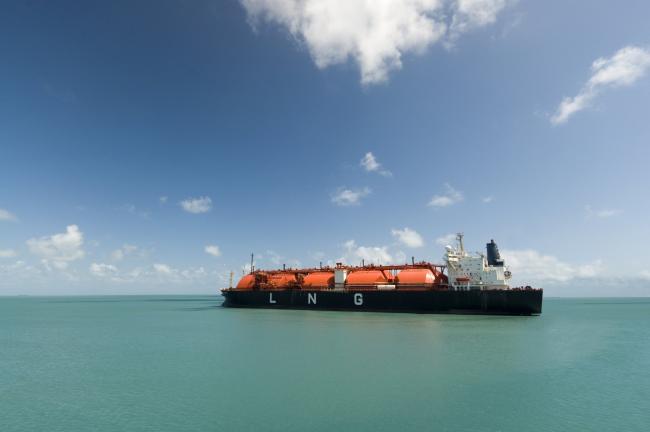Articles Menu

Oct. 7, 2025
On the same day the prime minister talked about the importance of “climate competitiveness” in keeping Canada’s economy strong and secure, his Liberal government gave the go-ahead to a major new piece of fossil fuel infrastructure.
Well, not quite.
The LNG terminal was one of five proposals Prime Minister Mark Carney showcased in Edmonton while announcing his Major Projects Office, a new agency tasked with shepherding “nation-building” projects through regulatory approvals processes quickly.
But what was left to do for LNG Canada 2, given they had all their regulatory approvals in place? The only thing holding it back is its consortium of investors — including Shell, Petronas, PetroChina, Mitsubishi Corporation and Korea Gas Corporation — who have been hesitant to put their dollars on the table and make a final investment decision.
In fact, while “climate competitiveness” is still officially undefined, it’s worth examining whether LNG Canada 2 is even economically competitive, given that investors have sat on their hands for so long.
Perhaps that's because the outlook for BC’s fledgling LNG industry is mixed at best. The one operational terminal (LNG Canada 1), and two under construction (Cedar and Woodfibre) are competing with well-established, lower-cost exporters ramping up production in Australia, Qatar and the United States, among others. Analysts expect a glut in the world market starting in 2026. In BC, two other large LNG projects (LNG Canada Phase 2 and Ksi Lsims) have received the green light from the government, but still await final investment decisions.
The federal government’s full-throated endorsement of LNG Canada Phase 2 is bad news for anyone who cares about Canada’s carbon emissions, or Canadians’ tax dollars, writes Janetta McKenzie - Blue Sky
Demand from China, the largest global buyer of LNG, has declined throughout 2025 and Beijing also appears to be exploring closer economic ties with Russia, including plans for a new gas pipeline.
If industry is not ready to make a final investment decision, I am concerned that the PM, in his eagerness to produce “nation-building” Canadian megaprojects, will drag an uncompetitive business case over the finish line using taxpayers’ money. Carney said the major projects office would be “discussing various federal incentives” with the proponents, but that any public support would be “modest” in comparison to the project’s capital cost.
Even a large number could be described as modest next to the terminal’s overall $32 billion price tag. It could also be argued that Carney has put himself in a vulnerable negotiating position by publicly committing himself to the project moving forward. He’ll feel a lot of political pressure to return to the podium soon with some kind of deal. Investors will surely note this.
Carney promised that a list of additional major projects would be released in the next two months and that he would also unveil a “climate competitiveness strategy” later this fall.
On the climate side, the new terminal would be a major new carbon emitter. The BC government has retreated from its earlier insistence that all terminals be net-zero, and LNG Canada plans to power the terminal’s energy-hungry liquefaction plants by burning natural gas.
Pembina Institute’s research indicates that if built, LNG Canada Phase 2 will be responsible for 2.1 million tons of carbon emissions from the terminal itself in 2030, plus another 4.7 million tons from increased upstream production to supply it. This is roughly 75 to 80 per cent of the BC government’s targeted 2030 emissions for the entire oil and gas sector. For context, existing industrial and LNG plants under construction will emit 192 to 208 per cent of that target. If all the proposed LNG terminals move forward, BC oil and gas emissions could be more than three times the sector target by 2030.
Carney touted the new terminal’s emissions as being best in class and significantly lower than the world average. But it’s a poor boast to say you’re polluting less than your neighbour when both of you are polluting a lot.
Powering the LNG terminals with renewable energy would substantially reduce those emissions, but there simply isn’t enough existing hydropower to serve all the proposed terminals or plans to build enough new renewable energy in the province. British Columbians must also ask themselves if sinking this precious resource of low-cost electricity into fossil fuel export is putting it to the best use. Upcoming research from Pembina will show the significant opportunity cost of this approach, especially given how rapidly the world is moving away from fossil fuels, including LNG.
Ultimately, any project that could plausibly be called “climate competitive” should be able to succeed on its own economic and environmental merits. As the federal government builds out this strategy — and fills future major projects lists — I encourage the prime minister to select the projects and policies that win on both sides.
Janetta McKenzie is the director of the oil and gas program at the Pembina Institute. She works on energy policy development, natural gas certification, and industrial decarbonization in Canada.
[Top photo: The federal government’s full-throated endorsement of LNG Canada Phase 2 is bad news for anyone who cares about Canada’s carbon emissions, or Canadians’ tax dollars. Photo by Shutterstock]